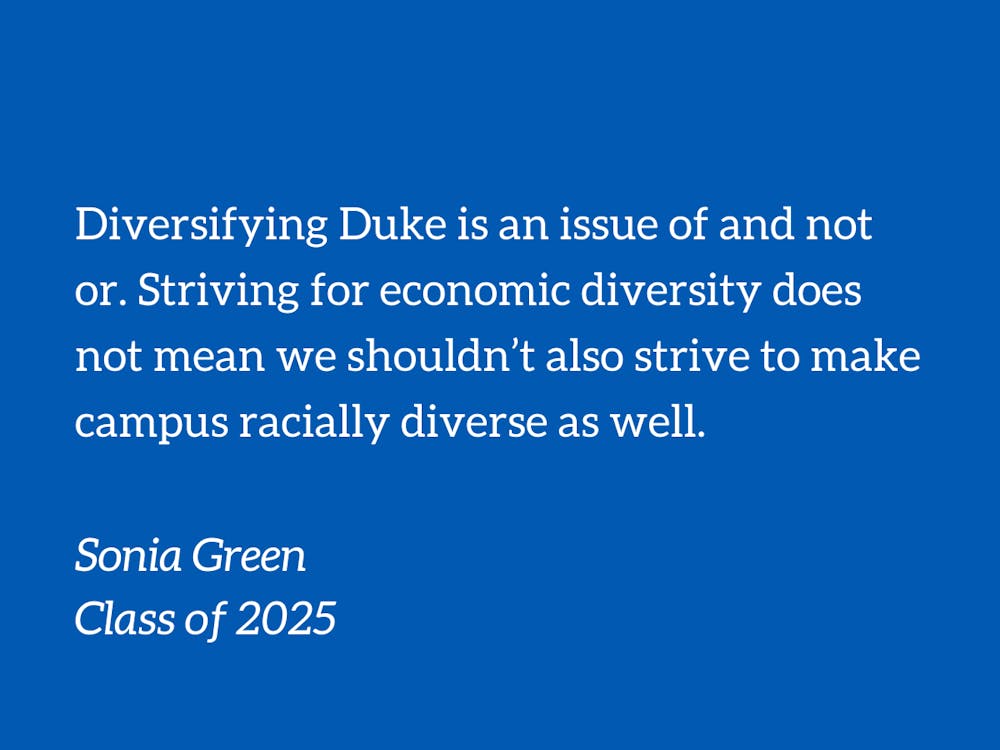Duke’s lack of economic diversity made national headlines recently when the New York Times released an article titled “Why Does Duke Have So Few Low-Income Students?” A few days later, Duke’s President Vincent Price released a statement attempting to showcase ways that the university supports and encourages low-income students. While the university is doing many things correctly, I would argue — mainly from personal experience — that despite these initiatives, Duke does in fact have a problem with economic diversity. There is no denying that. When students furnish dorms as if they are moving into mini apartments, park Teslas in Blue Zone and across campus, spend large amounts of money on alcohol and Ubers to and from off-campus frat parties and plan costly fall, winter and spring break trips, it is impossible to ignore that this campus oozes wealth.
This comes on the heels of many heated conversations about affirmative action and the lack of racial diversity in higher education. In January I wrote a piece on the value of affirmative action, which in the context of higher education entails admissions processes that consider applicants’ background characteristics such as race in an effort to increase diversity. Since then, the Supreme Court has ruled that race cannot be intentionally considered as a factor in college admissions. Some academics have suggested that universities focus on increasing socioeconomic diversity as a substitute for affirmative action. But if schools like Duke are clearly struggling to maintain economic diversity, and are also formally barred from maintaining racial diversity, what can Duke do to achieve a more diverse student body?
The New York Times article cites a recent study that found that Pell Eligible students make up only 12% of Duke’s student body, less than the Pell shares at Harvard, Yale, Princeton, M.I.T. and Columbia which have all recently remained at around 20%. This metric is important as it represents students whose families earn $60,000 or less a year. In terms of race, Black, Latino and Native communities are still underrepresented on campus. All of this is also very apparent from the student perspective and shows how Duke is struggling in both regards. It begs the question: What next?
Diversifying Duke is an issue of and not or. Striving for economic diversity does not mean we shouldn’t also strive to make campus racially diverse as well. We must strive to increase the number of low-income students and look for ways to increase the amount of Black and Brown students on campus. This sort of approach might actually help yield more low-income students of color, allowing us to reach out to a demographic of two underrepresented identities. By focusing on increasing the amount of low-income students on campus, without regard to race, Duke could wind up with a predominately white group of students. This means that we miss a great deal of diverse experiences that racial diversity also provides. However, by focusing on the and, we open the door to low-income students of color, ensuring that their intersectional identities are celebrated as well.
We must also remember the history of higher education which sought to exclude women, low-income students and students of color. Like at many other selective schools, administrators at Duke dragged their feet when it came to diversifying campus. They saw opening Duke to women as a step forward while remaining racially segregated until 1963, and since its inception, higher education has largely catered to those who can afford it.
Today, Duke is in a tough spot. While we have come a long way as an institution, we still have a long way to go when it comes to diversity. The end of affirmative action certainly does not help us, nor does the growing idea that the college admissions process should be purely meritocratic. This only hurts marginalized communities. Diversity, in all its forms, is something to be celebrated and sought after. I urge Duke administration to continue fighting for underrepresented students because there is still work to be done. I hope that in the coming years, I will be able to return to Duke as an alum and see a vibrant campus full of racial, economic and many other forms of diversity. To do this properly we must first recognize when we as an institution have a problem and look to the future with optimism. Because where there is a problem, a solution almost always exists.
Sonia Green is a Trinity junior. Her column typically runs on alternate Tuesdays.
Get The Chronicle straight to your inbox
Signup for our weekly newsletter. Cancel at any time.

